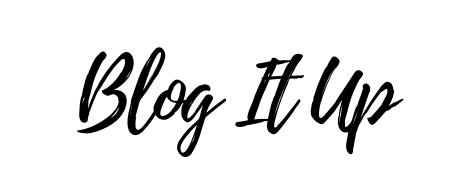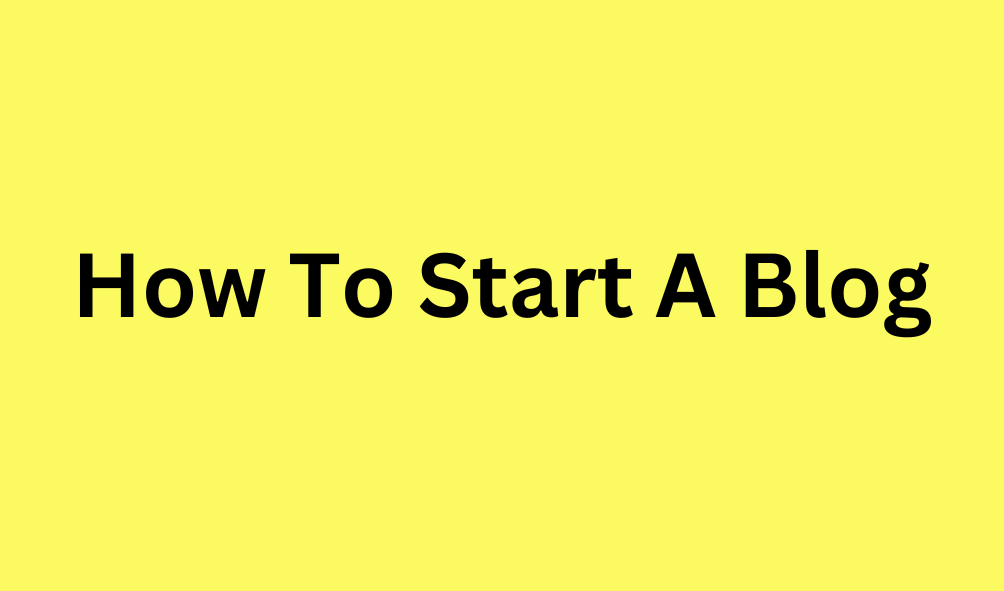How To Start A Blog
Are you planning to start a blog? If so, that’s great!
Starting a blog can be one of the most rewarding things you ever do. You get to share your passions and interests with others and maybe even make some money. It can have a big positive impact on your life.
But if you’re new to blogging, it can be overwhelming to know where to begin. You might not know what blogging platform to choose, what kind of content to create, where to find readers, how to generate revenue from your blog, etc.
I’ve been blogging for over three years now, and much of that time I spent trying to figure out all of the above, mainly because I didn’t have anyone coaching me when I started.
I thought it would be helpful to write down everything I’ve learned along the way.
In this comprehensive guide, I’ll take you from zero experience all the way through building your first blog. We’ll cover everything from choosing a blogging platform to getting traffic from search engines.
Note: This post contains an affiliate links, which means I earn a little when you purchase using these links at no additional cost to you.
Sign Up And Get A Free Keyword Research Course In Your Mail Box To Increase Your Google Rankings!
What Is A Blog?
A blog is a website that contains a regularly updated content feed, usually in reverse chronological order (i.e., the newest items are first).
It can be on any topic the author wants, usually written by one person or a small group.
There are many different types of blogs based on the author’s motivation and intent.
For example, some blogs report on current events, others provide commentary on political issues, and some focus on technology and science topics. In contrast, others write about lifestyle and topics like parenting or sports coverage.
Why Should You Start A Blog
If you’re still on the fence about starting a blog, here are a few reasons why you should:
- Get connected with people who share your passion.
- Grow your business/brand as well as yourself.
- Improve your writing skills.
- Learn new things every day.
- Become an authority in your niche.
- To increase your social media presence.
- To gain more visibility in search engines.
- You can make money from it.
How To Start A Blog
1. What Is This Blog About:
When you’re just starting out, it can be hard to determine the purpose of your blog. But it’s important to know what you’re trying to achieve with your writing.
Many bloggers start out with a specific purpose in mind that doesn’t necessarily reflect what their blog has become or what it will become.
You might set out to write about one thing (for example, gardening) but find yourself getting more and more interested in another topic (home improvement).
If you’re not sure what your blog’s purpose is, try asking yourself these questions:
- Why do I want to start a blog? Is there something specific I want to accomplish? What do I want people to walk away from my posts with?
- What do I want my audience to feel when they read my content? Is there an emotional connection I want them to have with me?
- What kind of tone am I aiming for? Am I writing for fun, or am I trying to be serious and informative?
The purpose of your blog should be clear, and you should be able to answer the question: “What is this blog all about?”
If it’s unclear, you will have difficulty defining who your audience is and how to attract them.
This is why you need to start by defining your purpose and knowing what you want from your blog before writing or thinking about building a website.
Once you’ve decided on the purpose of your blog, it’s time to decide on some features.
Is it for personal use, or are you trying to make money? If it’s for personal use, then there is no need to spend so much time and effort creating an amazing website.
However, if you want to make money from your blog, you need to ensure that your site is professional looking and easy for visitors to navigate through.
2. Choose a blogging platform:
One of the crucial steps to starting a blog is choosing the right platform.
Blogging platforms are often called “content management systems” (CMS) and allow you to build your website without knowing how to code.
There are hundreds of different blogging platforms available, but it’s essential to find one that suits your goals and needs.
Here are some things to consider as you make your choice:
Easy To Use:
Find a platform that is easy to use and doesn’t require learning complicated code or hiring someone to do simple tasks for you.
Options and Add-ons:
Some platforms have more features than others, so make sure you know what’s available before signing up for a plan.
Some offer additional tools like SEO optimization tools or analytics packages, while others don’t provide anything other than the basic service.
Flexibility and customization:
When choosing a blogging platform, it’s important to consider how much flexibility and customization you want. Some platforms aren’t as flexible as others or only offer limited customization options.
Costs:
There are many different types of platforms with varying costs. There’s something for everyone, from free platforms like Blogger to paid ones like Squarespace.
However, it’s important to remember that the more features a platform offers, the more expensive it’ll likely be. You might even find that some platforms cost as much as 30$ per month!
It all depends on your budget and what kind of experience you’re looking for in your site design and functionality.
Platform support:
Your blog will be around for years, so the platform must have a large community and good documentation to help you learn how to use it.
Security and performance:
Security is important because it’s a reflection of your brand. You can lose traffic, trust, and revenue if your blog is hacked.
Higher-quality platforms have better security measures built-in to keep hackers out (and sometimes even catch them in the act).
Blogging platforms also differ in terms of performance. Some are faster than others or easier on your server resources, so they don’t slow down your website or affect other users’ experiences with your site.
Now, you need to check out these before choosing a blogging platform. And my recommendation is WordPress.org.
Why? I’ll explain.
WordPress.org is an open-source platform that allows you to build websites without worrying about coding or design. The software is free, and there’s plenty of support from the community.
The platform has been around for more than 15 years, and it’s used by millions of people across the globe who are building everything from simple blogs to complex online businesses. In fact, 43% of sites on the interest are powered by WordPress.
Also, the platform has been built up over time by many developers who have added new features such as e-commerce functionality, custom widgets, and much more.
3. Choose a web hosting service:
Once you are done choosing the right blogging platform, you can begin your journey of finding the best web hosting provider according to your needs.
But what exactly is web hosting?
Web hosting is a service that allows you to get your website online. It’s like renting an apartment; when someone rents an apartment, they don’t own it; they’re just paying for the right to use it for a certain amount of time.
The same thing goes for web hosting: you pay for access to space on the internet so that people can visit your website from anywhere in the world.
There are four types of popular web hosting services:
1. Shared Hosting: This service allows multiple users to share the same server space and resources. It is usually cheaper than other options.
2. Dedicated Server: A dedicated server gives you complete control over your entire hardware, so you can use it however you want without worrying about sharing resources with others.
Dedicated servers also have higher security, performance, and reliability than other hosting solutions. However, if you plan to start a simple blog, you don’t need this type of server.
3. Virtual private servers (VPS): A VPS is similar to a dedicated server in that it offers all the resources you need to run your business online but at a lower price point because it’s shared with fewer users.
4. Managed WordPress Hosting: This is one of the most popular types of hosting for bloggers that are just getting started. With this hosting service, the provider takes care of all the technical aspects of running your website, including security updates and backups.
This means you don’t have to worry about keeping your site secure or managing any technical updates yourself.
However, choosing a web hosting service can be a daunting task. There are so many different companies out there, with so many different packages and pricing options.
How do you know which one is right for your blog?
Reliability:
Reliability is among the most important factors when considering which host to use. Your website must be up and running constantly so that potential audiences can access it at any time. You could lose viewers and revenue if your site goes down even once.
Uptime Guarantee:
Another thing to look at with any host is whether or not they offer an uptime guarantee. The standard uptime is 99.9%; anything lower than this can lead to problems with your website being unavailable when users try to access it.
If you don’t know how to look for your hosting server uptime, google “web host name+ uptime.”
It is pretty rare to find 100% uptime.
Price:
Web hosts charge different rates depending on how much storage space you need, how many visitors your site gets per month, and what features are included in their packages (e.g., e-mail accounts). Some companies offer discounts if you sign up for longer terms.
Bandwidth:
Bandwidth usage refers to the amount of data transferred over a network during a specific time. It is often used to indicate network performance and is most commonly measured in gigabytes (GB).
If you plan to have a lot of pictures or videos on your site, ensure your host provides enough bandwidth so they load quickly and smoothly.
Some web hosting servers do offer unlimited bandwidth with the package.
Customer Service:
Customer service is also vital when looking at hosts because if there’s ever an issue with your site, you want someone who can help fix it quickly without causing any more problems.
Many options should be available, including phone support, live chat options, and email tickets, so you can reach their representatives directly without waiting on hold or dealing with automated systems.
Okay, these are the few things you must check before choosing a hosting service. Now, my recommendation is DreamHost.
Here is why, I have been using DreamHost for more than three years, and this company provides the best hosting services in terms of price and performance.
To start with DreamHost shared package, you only need 4.95$, and you will get free SSD storage, a Free SSL certificate, Unmetered Bandwidth, Unlimited Traffic, Free WordPress migration, and much more.
Here is a tutorial on how to start a blog with DreamHost:
1. Go to DreamHost’s official website by clicking here.
2. On the page, click “Get Started,” and you will land on the hosting packages page.
3. Now, choose your hosting plan.
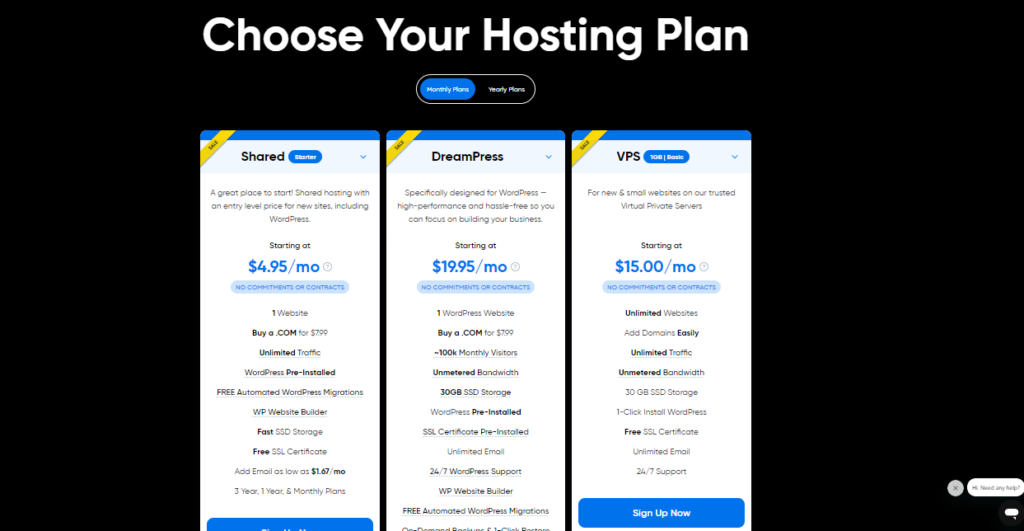
4. Once done, click on the “Sign Up Now” button.
5. Next, you will be asked to choose a domain. You will be given three options “Choose a domain later,” “register a new domain,” or “I already have a domain.”
Since we haven’t discussed picking a domain name, click “Choose a domain later.”
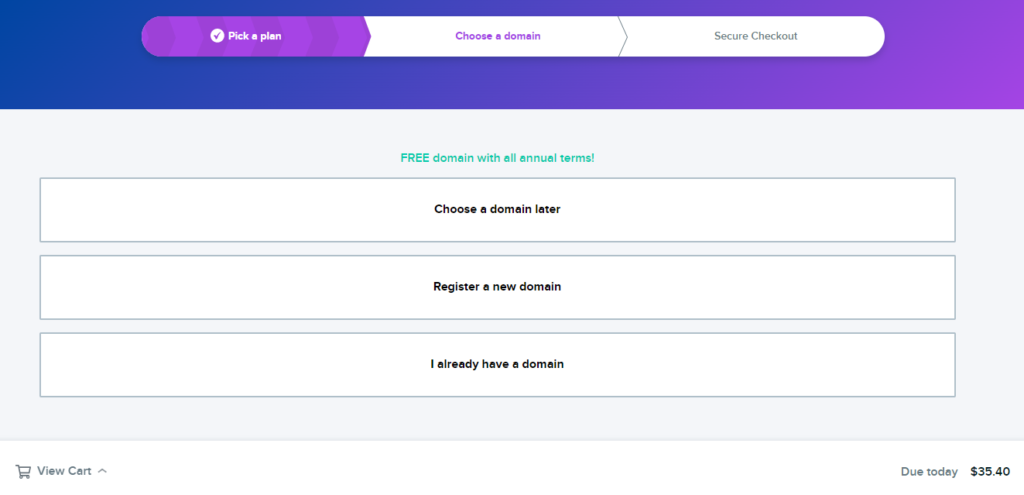
6. Add your payment information.
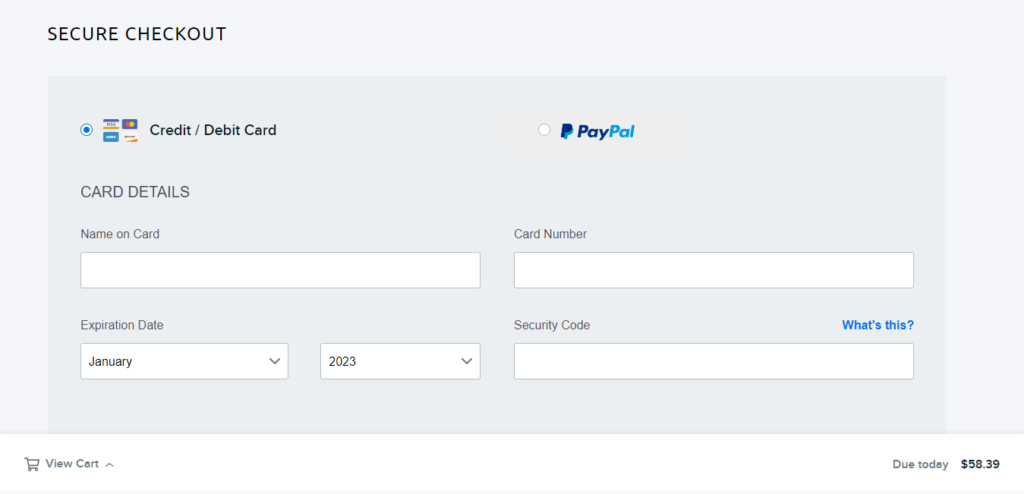
7. Set up your account.
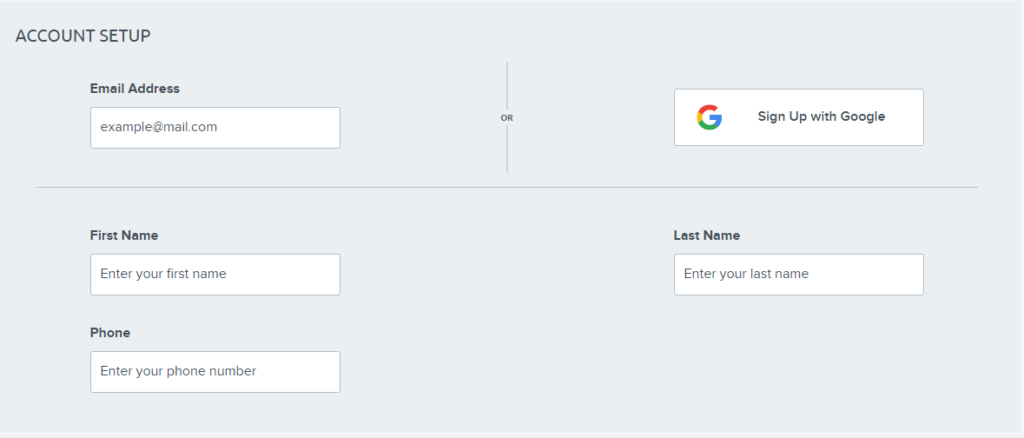
8. Add additional features if you like, such as DreamShield Protection (highly recommended), DreamHost Email, and Google Workspace.
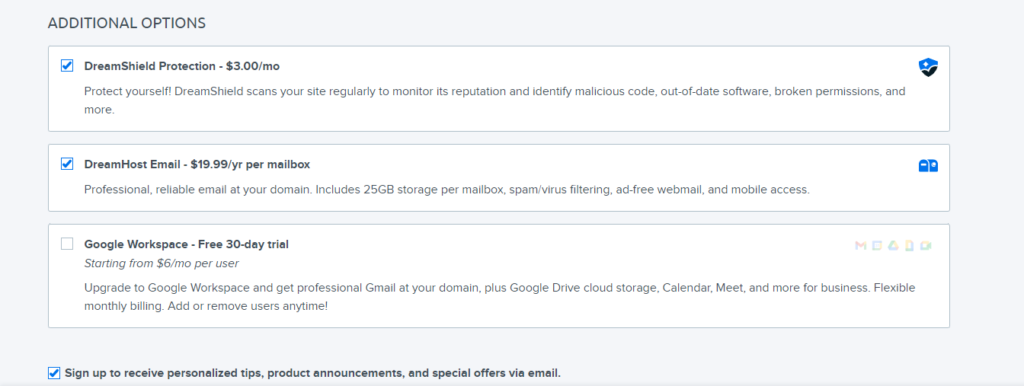
9. Finally, click “Submit Order,” and that’s it.

Do you want to know the best part? Almost all the DreamHost hosting plans come with pre-installed WordPress, so you don’t have to worry about downloading it.
4. Pick A Blog Niche:
It’s time to pick a blog niche.
When starting a blog, it can be tempting to dive right in and start writing about everything. But picking the right niche is essential if you want your blog to take off.
What is a blog niche/topic?
A blog niche is a specific topic or area of interest you want to write about on your blog. For example, my blog’s niche is “blogging,” meaning that all my posts are related to blogging somehow.
The goal of picking a niche is to narrow down the focus of your blog so that people can easily find what they want. As a result, it’s easier for them to read your content and subscribe to your email list.
If you’re having trouble choosing a niche, here are a few steps you can follow:
Choose a topic you are passionate about:
This may seem like a no-brainer, but it’s important to remember that your blog should be something you care about. If you’re not excited about your topic, it will show in your work, and readers will notice.
Pick a niche that is not too broad:
It’s easy to get overwhelmed when choosing a niche for your blog.
You want to find something specific enough that people can find your content when they search for it but not so narrow that there isn’t enough content available to fill up an entire blog post or series of posts.
Do some research with Goole Trends:
Use Google Trends to see what people search for the most. This will help you determine whether there is enough interest in a specific topic for you to write about it on your blog.
You can also use this tool to see what people are searching for in your local area or country if you want to target a specific audience.
Make sure there is low competition:
Choose a niche with low competition because these niches have fewer web pages competing for top spots, which means your content can rise higher in the search results.
The more competitive a niche is, the harder it will be for you to rank on Google (or any other search engine) and make money from your site.
Make sure it is a profitable niche:
If you’re going to invest time and money into building a blog, make sure there’s a potential for returns. It’s not enough to have an interesting idea; you have to make sure it’s profitable.
You can figure this out by researching how many affiliate programs are there for this niche and how other bloggers in a similar niche are making money.
5. Choose a domain name:
The next step to starting a blog is to choose a domain name.
A domain name is the part of the URL that comes after the “www.” or “http://” in a web address. People will see this when they visit your website, so it should be easy to remember.
For example, Google’s domain name is google.com. It’s easy for people to remember that name because it’s short and memorable.
Your domain name should be something that represents your blog’s purpose. It can be something creative (but still relevant).
The right domain name will help you build your brand and establish your blog as an authority in your industry.
When choosing a domain name, there are a few things to keep in mind:
Make it memorable:
Your domain name should be easy to remember so that people can find your site when they search for it.
Keep it short and sweet:
Longer names are harder for people to remember, so try to keep it as short and sweet as possible.
Make it specific and relevant:
Don’t just choose any old thing; think about what your blog is about, and make sure the name reflects this.
Keyword Friendly:
A good domain name should contain one or two related keywords or key phrases to the niche. This will help bring in more traffic from search engines like Google and Bing.
Make sure it’s available:
Search the domain name to make sure no one else owns it. If they do, you’ll have to come up with something else.
Here is how you can check if a domain is available and buy it:
1. Go to Namecheap.com.
2. Click “Sign up” at the top of the page.
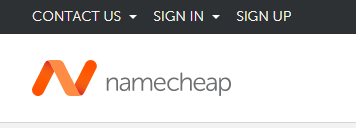
3. Next, fill in the required information to create an account.
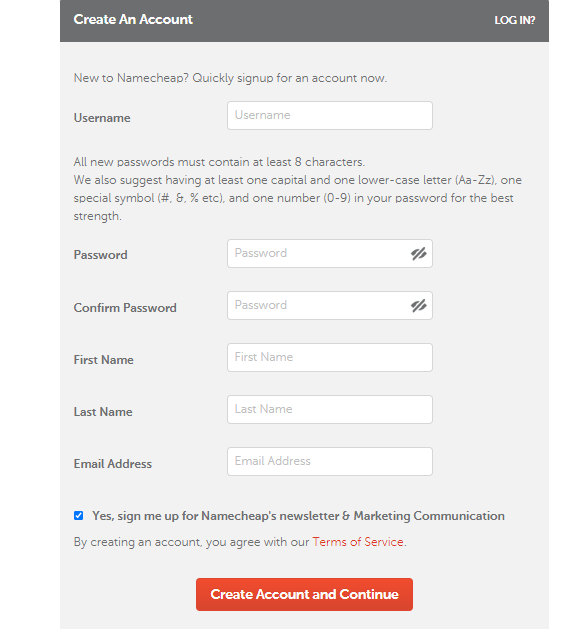
4. Type in the domain name you plan to get and click the “magnifying glass icon.”

5. Next, if the domain is available, click “Add To Cart.”
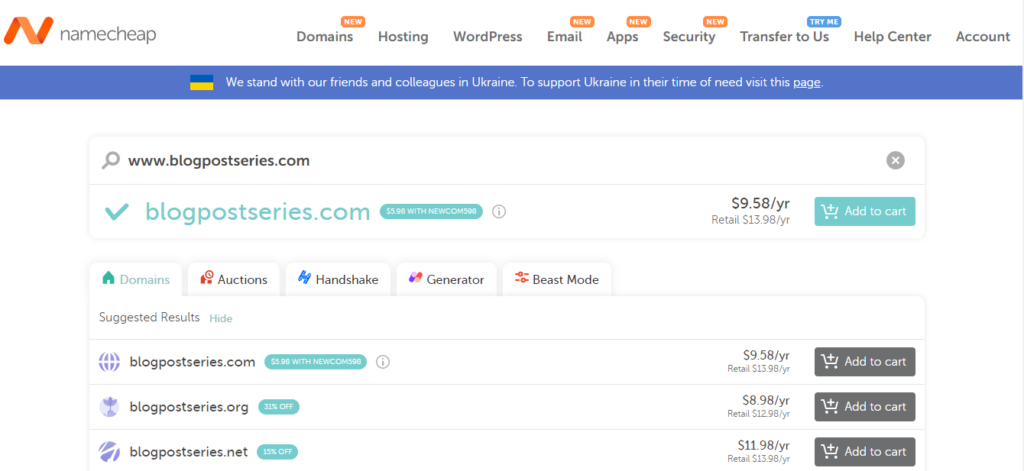
6. If it’s already taken, you can scroll down to see the suggested names that are available. If you like any, add it to the cart; otherwise, type in another name.
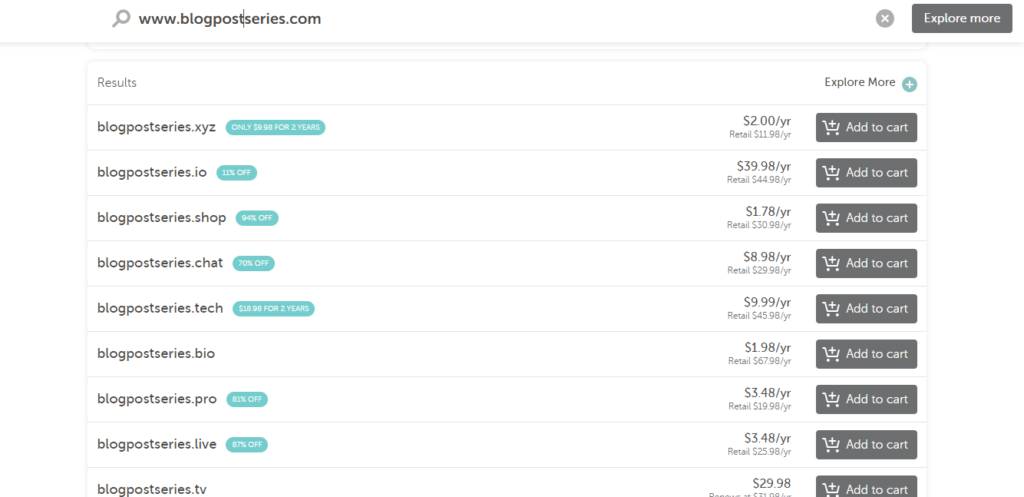
7. Once you are done, click “Checkout” at the bottom of the page.

8. Next, fill in the contact information.
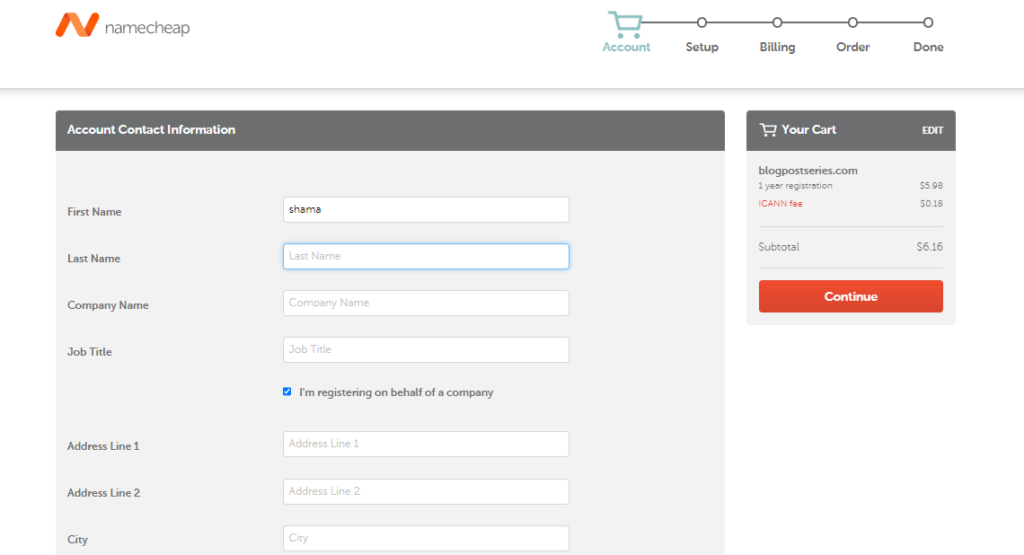
9. Finally, add your payment information, review your order, and click “Pay Now.”
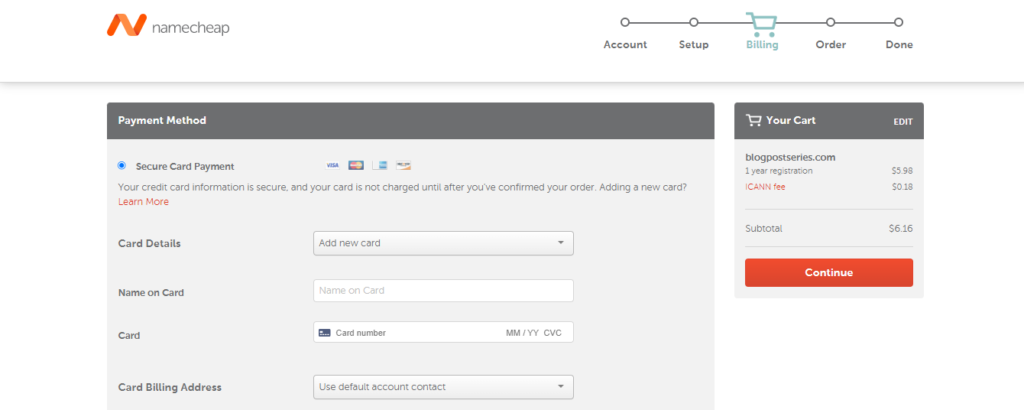
That’s it; you just purchased a domain name using Namecheap.
You can also register a domain name with your hosting service. In fact, when I signed up for DreamHost yearly package, I got my domain name for free.
6. Select a theme and design it:
Once you have decided on your blog’s domain name, it is time to start thinking about choosing a professional theme.
A theme is a template for your blog, meaning it is your site’s layout and design.
It can be as simple as a basic layout with text and images or more complex with widgets, menus, and other elements that make the site more interactive.
You have two main options when it comes to choosing a theme:
Free themes:
Free themes are great because they’re free and easy to use. However, they often come with a lot of limitations. Some don’t include support or updates, which means you’ll have to pay someone else if there’s ever an issue with your site.
Premium themes:
Premium themes are often expensive, but they offer more customization options and better support than free themes. If you’re willing to spend money on your new blog, then premium themes are worth considering.
For my blog, I use the Zakra theme. It’s been two years, and so far, it’s going great. Zakra has two options free and premium.
To create a simple blog, the free version is enough, but if you love to have more control over your site, then go for the premium version.
Here are some factors to consider when choosing a theme:
Ease of use:
If the theme is too complicated for readers to navigate, they will likely leave your site without reading more than one post.
Appearance:
Your blog should look professional and appealing so people will want to read it.
Responsive design:
Responsive design ensures that your site looks good no matter what device it’s being viewed on, such as desktop computers, laptops, tablets, or smartphones.
Functionality:
Choose an intuitive and easy theme so you don’t have to spend time tweaking every setting.
Customizability:
You can customize almost any theme using plugins or coding knowledge, but choosing one with built-in customizations can make your life easier when you first start.
User experience (UX):
A good UX means visitors aren’t distracted by confusing navigation or poor design choices like clashing fonts and colors. It also means ensuring each page loads fast so visitors aren’t left waiting around.
Budget:
Themes are available in all price ranges, but the more expensive ones typically have more features and customization options.
If you’re on a tight budget, consider choosing a free theme or one with a free version and upgrading to premium later.
Security and maintenance:
It’s important to choose a secure theme because hackers will try to break into your website if they notice vulnerabilities in your site’s code or design structure.
Also, make sure that the developer has an active support team who can help you with any issues that come up during installation or later.
Here is the benefit of using WordPress as your blog content management system.
WordPress has a built-in theme store where you can browse through hundreds of free themes (and premium ones, too). You find themes ranging from simple and minimalistic to beautiful and complex.
If you don’t find anything you like there, you can also check out Astar themes or hire a professional designer to create one for you.
Here is how you can download a third-party theme on WordPress:
1. Download the zip file of the theme from the official theme website (avoid downloading theme zip files from random websites, even if it’s free).
2. Go to your WordPress account dashboard.
3. On the menu, click “Customize” and then “Change Themes.”
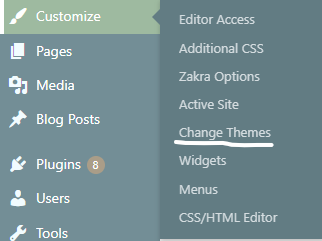
4. On the top of the screen, you will see the “Add New” button; click on it.

5. Next, click “Upload theme.”

6. Now, click “Choose File” and select the zip file you downloaded from the theme’s official site.

7. Click “Install Now.”

8. Once your theme is installed, scroll down, and you should be able to see the theme.
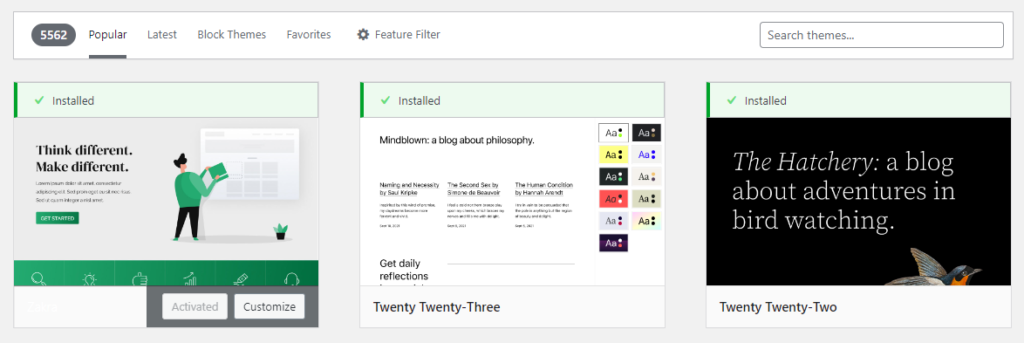
Click on the theme and start customizing it to create the best-looking blog in your niche.
7. Create a logo for your blog:
If you’re going to put in the time and effort to create an online presence, then why not make it look good?
Your blog is more than just a website. It’s a brand that deserves the same level of consideration and care as any other business entity.
Your logo is an essential part of that brand. It should be unique, memorable, and professional. It should also look great when shrunk down to fit on your blog’s sidebar or email signature.
There are many different approaches when it comes to creating a logo for your blog. You can start from scratch or use pre-made templates from online resources.
Here are some tips for creating a logo:
Keep it simple:
Keep it simple, and don’t crowd it with too many symbols or icons, no matter how much you want them to include in your logo.
Make it memorable:
A logo should be easily recognizable by all users, including those unfamiliar with your blog. It should also convey the message of your blog in an instant.
Use colors that suit your brand:
Use colors that match your brand identity and reflect the tone of your content. If it’s formal (like a business blog), stick with more conservative colors like black or dark blue, but if it’s more playful (like a parenting blog), try bright colors like yellow or orange.
Use visual elements that fit:
Use visual elements that fit your site’s branding and make sense for what you’re doing (e.g., put a money icon if you are writing about personal finance).
Choose the right font style:
The font used in your logo should be easily readable in all sizes. Also, choose a font style that fits your blog’s theme and matches other elements in your branding.
Get inspiration from other brands:
You can also look at similar blogs in your niche to get ideas on how they’ve created their logos.
Creating a logo from scratch is the best option because it will stand out from the rest of the blog’s logo in your niche.
On the other hand, if you have no experience or design skills, I recommend using Canva to create your logo. It’s free to use, and it has pre-made templates for blogs and social media accounts that make designing easy.
Make sure to read Canva’s Content License Agreement before creating any logo so you don’t find yourself in any legal trouble later on.
Here’s how you can create a blog logo with Canva:
1. Go to Canva.com and log in to your account; if you don’t have one, just sign up using Google, Facebook, or Emai.
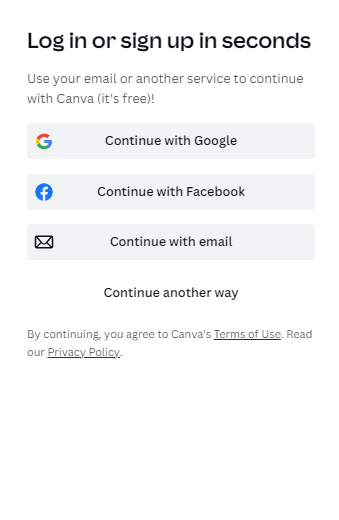
2. Once you have logged in or signed up in the search bar, type logo, and press enter.
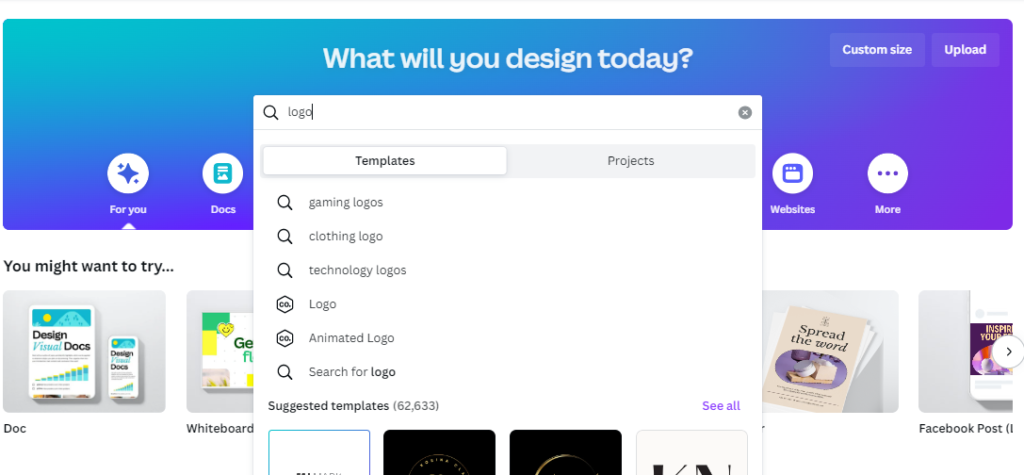
3. Now, choose a template you like and click on it.
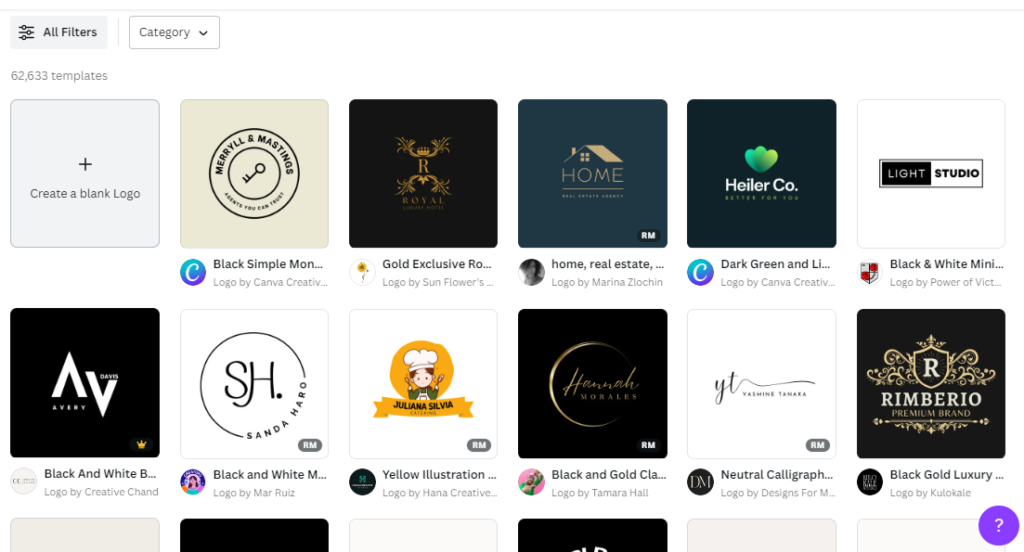
4. Next, click “Customize this template.”
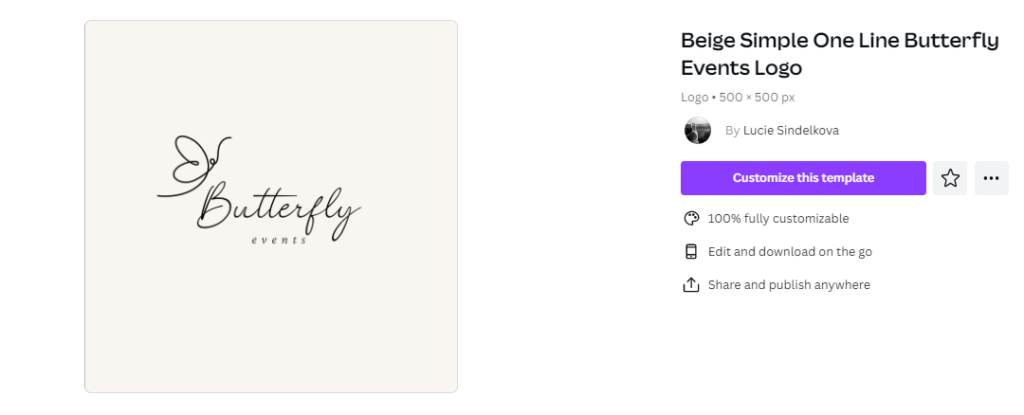
5. Now, start making some changes. Remember that Canva has a strict rule that you can not use any template without making any changes first.
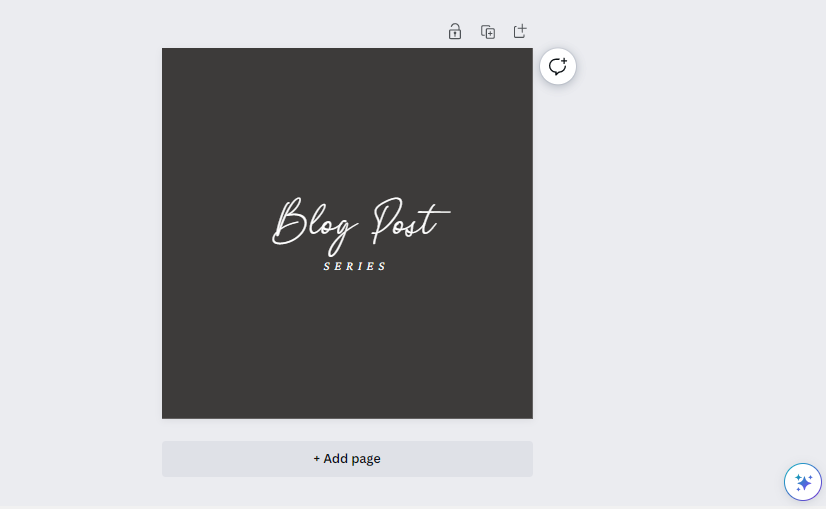
6. Next, name your design.

7. To save your logo, click on “Share,” and then from the drop-down menu, click “Download.”
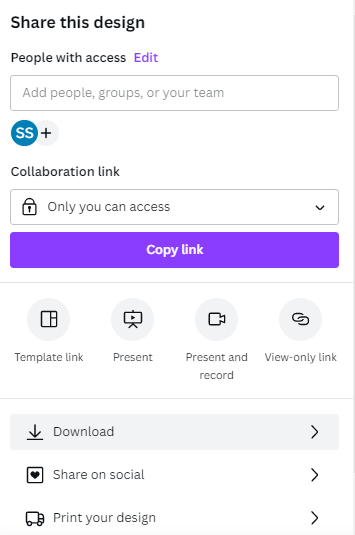
8. Select the file type (PNG is suggested) and click “Download.”
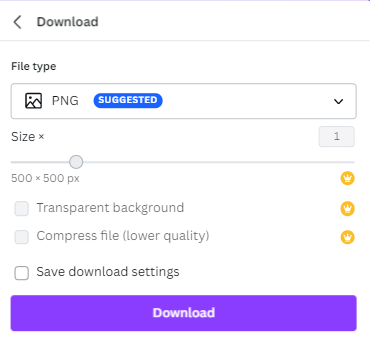
That’s it.
If, for some reason, Canva is not the right choice for you. You can use other resources like Tailor Brand, Adobe, etc.
8. Create a list of blog topics:
As you start your blog, you must have a list of topics in mind. This will help you generate content for your blog and give you an idea of what direction to take with your blog.
The topics should be broad enough to be used as a starting point for articles.
It should also be specific enough to appeal to readers and help them solve their problems or answer their questions.
A good example is the topic of “blogging.” This broad topic can be expanded into different subtopics like starting a blog, making money from blogs, etc.
If you are not sure how to create topics for your blog, here are some tips:
Google it:
If you’re struggling to come up with blog topics, you can use Google to help. You only need to search your blog niche and then look through the results.
This will give you a good idea of what people are searching for and want to learn about.
Include keyword:
Choose a keyword related to your niche and create topics around it. Make sure the keyword is easy to rank, as it should be low in competition but high in demand.
Look at other blogs in your niche:
The next step to choosing a topic is to think about your niche or industry. You need to know what people in that niche are discussing and interested in.
You can read other blogs in your niche and see what topics they cover.
Somehow if you still can’t figure out what blog topics you want to cover, here are a few suggestions for any niche:
Interviews:
Interviews with others can be a good way to get people to talk about their experiences and learn from one another.
Reviews:
Whether it’s a review of a new tech gadget or a restaurant, people love reading reviews on blogs because they know they’re getting honest opinions from someone they trust.
How-to tutorials:
People love learning new skills through step-by-step tutorials, so if you can teach them something new, you’ll have no problem getting traffic from search engines like Google.
Tips and tricks:
They can be helpful for both newbies and experienced users, so they’re a great way to introduce new people to your site.
9. Write your first blog post:
There are many different types of blogs out there, but they all have one thing in common: they all need content. From personal blogs to business blogs, content is king.
The more unique and engaging your posts are, the better your chance of making your blog stand out from the crowd and attract new readers (and even get shared on social media).
But where do you start? Don’t worry; I have some tips to help you create an amazing blog post.
Keyword Research:
Before you start writing, spend some time researching what keywords your audience uses when searching online.
Keyword research can help you pick topics people are interested in reading about. It also gives you an idea of the competition for specific keywords and whether they’re worth pursuing at all.
You can use a free tool to conduct keyword research; here is how you can do it:
1. Go to Google and search for “Ahrefs Free Keyword Generator Tool,” or simply just click this link.
2. Next, type in your focus keyword and click “Find Keywords.”

3. You will see a list of keywords along with their search volume and difficulty.
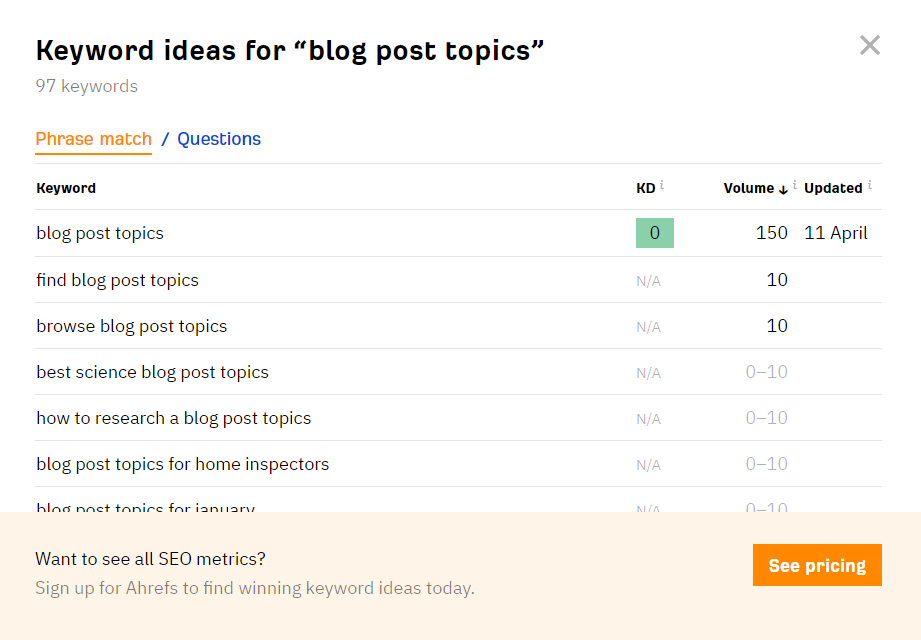
If the keyword difficulty is below 10 and the search volume is 100+, it’s a great keyword to write a blog post about.
However, if the search volume is 100+, but the competition level is too high, look for another focus keyword because, as a new blogger, it will be hard for you to rank for that keyword.
You can check out my “Free Keyword Research Course” In it, I share valuable tips.
Once you have a list of keywords, you can write content specifically targeting your target audience.
This will help your content rank higher in search engines like Google, which means more people will see it and hopefully click through to your site.
Create an outline before writing:
Writing without an outline will lead to a disorganized, confusing piece that will frustrate readers and make it difficult for them to find the information they need.
Instead, create an outline with all your main points to keep them organized and ensure they flow logically from one idea to another.
This will help ensure that your message is clear and easy to follow so readers can absorb what you’re saying quickly and easily.
There are two ways to create an outline for your post:
1. Look at other blog posts:
One of the best ways to create an outline for your post is to look at the top posts on the search engine result page (SERP) for the focus keyword.
See what point they are covering and what type of post it is. For example, is it a tutorial post, tips and tricks, or just an information post?
This research should give you a clear idea of the main points of your post. Do not copy these posts; use them to understand the focus point.
2. Search On Google:
Another method is to Google your post topic and look at the Search Queries, F.A.Q Section, and Related Searches.
You don’t need to include everything you see in these sections just add points that make sense with your post.
Write an introduction:
The introduction is the starting point of your blog post and the most important part because it’s what gets people to read more.
Your blog post should begin with an introduction that sets the stage for what’s to come. The first paragraph should be a teaser, enticing readers to continue reading.
Write an introduction that does not repeat what you have already said in your title.
Also, include your keywords in the first sentence or two. This will help Google find your post and will also help readers find it through search engines.
The introduction should be 100-150 words depending on the length of the post.
Write the body of your post:
This is the central part of your blog post. This is where you will share your ideas, thoughts, and opinions in a way that will be useful and interesting to your readers.
You want to make sure it’s not too long or too short, but it should provide enough details.
Also, give examples or statistics supporting your points (make sure these are backed up by reliable sources like high-authority websites or case studies).
Add subheadings:
Include subheadings in your blog post. This can be used to break up large sections of text and make it easier to read.
It also allows you to add more information or take a different approach to your topic.
Use bullet points:
Bullet points are a great way to organize information into digestible chunks. Use them to explain processes or steps or to summarize key points.
Include the target keyword throughout the post:
As you write your blog post, include your target keyword throughout the content. This will make it easier for search engines to find and rank your content.
One of the best ways to track keyword density is using the Yoast plugin.
Use Images:
Add images whenever possible. Images increase engagement, especially if they’re relevant to the topic or depict something that would take too long to explain in words alone (such as an infographic).
Write the conclusion:
The conclusion should summarize what was discussed in the body of your article/post. It should also include any additional tips or suggestions for your readers.
When you’ve finished writing your first blog post, proofread it thoroughly before publishing it online.
Grammar mistakes can be a big turn-off for readers. You can use Grammarly to help you out with proofreading; it is much cheaper than hiring a proofreader.
10. Create an editorial calendar:
When you’re trying to build your blog, it’s easy to get caught up in all the tasks. However, one of the things you can do for your blog is to create an editorial calendar.
An editorial calendar is a plan for how to publish content on your website or blog.
The calendar should be divided into months and weeks, with each day showing what you want to write about and when you want to publish it.
This can be as simple as a list of topics with dates or more complex, with several columns for different types of content and another for social media posts.
The benefit of an editorial calendar is that it forces you to plan ahead.
If you have an idea for a blog post but don’t know when you’ll have time to write it, the calendar helps you decide whether it’s worth putting in your schedule now or waiting until later.
It also helps prevent procrastination because once something goes on the calendar, it’s harder to push off until later without feeling guilty about breaking your commitment.
11. Promote your blog:
When you write a blog post and publish it to your site, you want people to read it, and one of the ways to make it happen is by promoting it.
Promoting your blog is the key to a successful blog. Without promotion, you will have very few visitors to your blog, and your hard work will go to waste.
Promoting can be time-consuming and requires a lot of effort, but it’s worth it when you see those numbers grow.
You can promote your blog in many ways, and the best way to find out which ones work best for you is to try them all out.
Here are some ideas:
Facebook groups:
There are thousands of Facebook groups dedicated to blogging and promoting your blog. Become a member of some of them and post about your blog there.
You also need to comment on other people’s posts because if they see you’re active in the group, they’ll be more likely to check out your blog.
Twitter:
Tweet about your blog every day, and make sure that you include hashtags with keywords related to what you write about (ex: #blogging #marketing #socialmedia).
This will get more people interested in you and increase your followers on Twitter.
LinkedIn:
LinkedIn is a great place for bloggers who want to build their network and attract new clients or customers.
Join groups related to what you do (ex: blogging community), join discussions there, and share tips and advice with others in those groups (or start one yourself).
Pinterest:
Pinterest is a great place to promote your blog. It has a huge audience, and people love to pin things they find interesting.
But since Pinterest is a visual search engine, you will need to learn about Pinterest SEO to get traffic to your blog, and I highly recommend this course, “Pinterest Rank Boost 2.0.”
Build relationships with other bloggers:
Find people in your niche who are blogging about similar topics as you are, and reach out to them via social media or email, asking how they would like to collaborate on something together or cross-promote each other’s blogs in some way.
Email list:
Email is the most direct way of communicating with your readers and subscribers. You can use it to share updates, ask questions, and promote content that’s useful to them.
The best way to get people to subscribe to your blog is by offering a freebie. This could be a free ebook, course, or webinar that helps address questions people might have about your topic.
Write Guest Posts:
Write guest posts for other blogs in your niche. These will give you exposure outside of your website and help build up your credibility in the blogging community.
Be sure that the blogs that accept guest posts are relevant to yours (and vice versa), or else you won’t gain much benefit from writing for them.
12. Monetize your blog:
Once you have a blog up and running, it’s time to start thinking about making money.
You can make money from your blog, and it’s not as complicated as you might think. You don’t have to be a full-time blogger to make some extra cash from your site.
There are many ways to monetize your blog. Some methods require more work than others.
The important thing is to find a method that works for you and your audience.
Ad Revenue:
The most common way bloggers make money is by displaying ads on their sites. This can be done through Google AdSense or other networks like Mediavine and AdThrive.
In exchange for showing relevant ads to people visiting your site, you receive a portion of the revenue generated by those ads.
The amount you receive will vary greatly depending on your audience’s size and how valuable they are to advertisers.
Before applying for any of these ad networks, read the guidelines.
Affiliate Marketing:
Affiliate marketing is one of the most popular ways to make money from your blog.
Affiliate marketing is earning a commission by promoting other people’s products or services on your blog or social media channels.
When someone clicks through your links and purchases with one of these companies, they will pay you a percentage of the sale price (usually between 5% – 15%).
One of the best affiliate programs is Amazon Associates. You simply sign up for it, add links in your posts, and then every time someone clicks on those links and makes a purchase on Amazon, you get a commission!
Sponsored posts/reviews:
Some companies will pay bloggers for sponsored posts or reviews on their blogs.
These posts usually look like average blog posts but are paid for by a third-party company in exchange for the promotion of their product/service.
Sponsored posts should always be marked with “sponsored” or similar language so readers know they’re reading paid content; otherwise, you will be violating Google and FTC guidelines.
Sell Your Products:
If you want to make money from your blog, selling products is one of the best ways to do it.
You can sell anything: digital products, physical products, or even services. It all depends on your audience’s needs and how much they are willing to pay.
One thing that matters when selling a product is that you have high-quality content on your blog discussing the topic of the product you’re selling.
Conclusion
That folks, is how you start a blog. Those are all the steps you need to get a blog up and running.
The process may seem intimidating at first, but if you follow these steps, you’ll be well on your way. Just a few months from now, you could be blogging from your living room and gaining an instant following.
F.A.Q
Q: Is blogging easy?
It’s easy to start a blog, but building a successful blog takes time and effort. You will need to share your expertise, be patient with getting traffic, and commit to keeping your blog updated frequently.
Q: Is it risky to start a blog?
No, there isn’t much risk involved in starting a blog. It is actually pretty easy these days. With free blogging platforms like WordPress and Blogger, you only need an idea and basic technical skills.
The only real risk comes from the fact that you need to put in a lot of hard work and time before you start seeing results.
Your earnings will depend on how well you promote your blog and how many visitors you get daily.
Q: Is blogging a good career?
Blogging is a great career option, especially for people who love to write. It can be a full-time job or a side hustle to supplement your income.
Q: How to start a blog for free and make money?
These are the steps you need to follow to start a blog for free and make money from it:
- Pick a niche.
- Understand your target audience.
- Choose a blogging platform.
- Register and set up your blog.
- Write your first blog post and publish it.
- Include affiliate links in your posts.
Q: Does blogging need money?
You don’t have to spend money to start blogging. You can use free blogging platforms like Blogger and WordPress.com, which offer free hosting.
However, if you want to build a successful blog and earn money from it, you must invest some money into it.
Q: Do beginner bloggers make money?
The answer is yes, in some cases, but how much they make depends on how much time they put into it, what kind of content they share, and how well they monetize their site.
Sign Up And Get A Free Keyword Research Course In Your Mail Box To Increase Your Google Rankings!
- 140+Tumblr Blog Names - April 27, 2024
- How Much Does It Cost To Start A Blog? - April 25, 2024
- 24 Blogging Mistakes To Avoid - April 21, 2024
